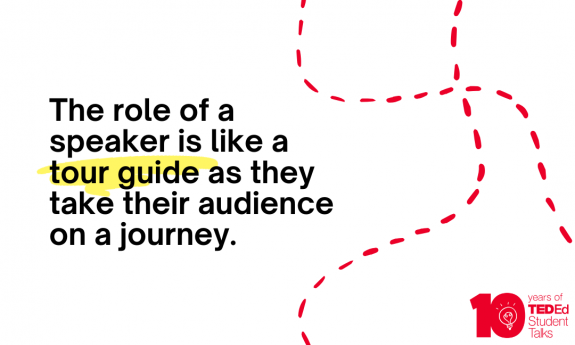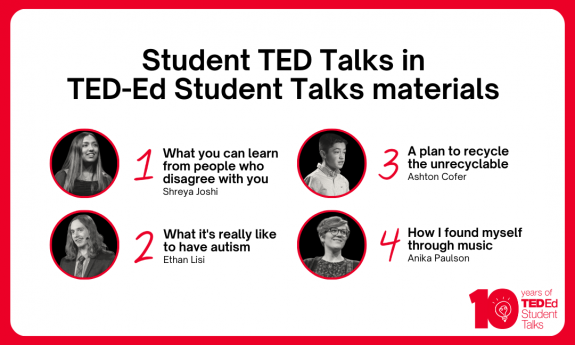10 highlights from the new-and-improved Student Talks resources
By TED-Ed on July 8, 2024 in News + Updates, TED-Ed Clubs

Xixi Wang
At TED-Ed, we’re passionate about sharing diverse and meaningful student voices with the world.
Since 2014, thousands of student groups across the globe have been developing and sharing their ideas using our free TED-Ed Student Talks resources.
To celebrate 10 years of TED-Ed Student Talks (also known as TED-Ed Clubs), we are introducing a new “10 for 10 years” series. The first in this series highlights 10 updated features from the new-and-improved Facilitator Guidebook and Student Idea Journal! We will continue to celebrate this exciting milestone with additional posts as part of this series.
“A great talk can have a huge impact — maybe on millions of people, maybe on just one. But no talk can be great without a lot of thought and hard work. The best speakers go through a process to transform their idea into something others want to share.”
Feedback from facilitators who have used the Guidebook and Student Idea Journal with students in primary and secondary schools have enabled these materials to become even more flexible, fun, thoughtful, and aligned with 21st century skills.
So, what’s new? Creative analogies that represent the talk journey, guidance on effective source evaluation and fact-checking, student TED Talks that serve as models, and facilitation planners to help leaders customize their experience.
Here are 10 new features you can expect from our latest resource release:
1. Enhanced facilitator support
The updated Facilitator Guidebook helps facilitators adapt and customize our 13 Explorations (modules with activity blocks) to engage students in discovering, developing, and sharing their TED-Ed Student Talks. We’ve provided tips, space and timing estimates to help plan effectively while aligning these materials with important learning objectives like identifying and reflecting on their experiences and curiosities, researching and thinking critically about ideas, writing and presenting compelling stories, giving and receiving feedback, and understanding the perspectives of others. We’ve also made it easier for facilitators to move between the two core resources, our Facilitator Guidebook and Student Ideas Journal, and truly use these resources in tandem.
2. The water you swim in
During his graduation speech, David Foster Wallace tells a short fable about fish swimming in water, which highlights that we often aren’t aware how our day-to-day experiences might differ from the experiences of others. We use this fable and the analogy of the water we swim in everyday to ask students to explore their own experiences more deeply because when we understand ourselves more fully, it can help us identify what ideas we have to share. This framing helps students grow their cultural and global awareness, perspective taking, and critical thinking skills.
“To give a truly powerful talk, it helps to start with a topic that excites you, in some way defines you, or about which you care deeply.”
3. An idea is like a gift
Great speakers give their audiences a gift that they can apply to their lives and use to expand their perspectives. That’s how great ideas can spread. In these new activities, students think about how an idea is like a gift, and what gift they could give their audience. This helps students with listening and critical thinking skills.
4. The tour guide and the talk roadmap
We compare a successful speaker to a tour guide, in the way they guide their audience on a tour of their idea and ensure that everyone has the information they need to follow along. In this activity, students use the talk roadmap planner to identify what to include in their talk in order to support their idea and take the audience on an engaging journey from start to finish. This new concept helps students with writing skills and tandem peer feedback activities help with students’ listening skills.

Xixi Wang
5. Research and source evaluation
Thorough research is the best way to prepare for critics or skeptics in any room. With TED-Ed Student Talks activities, students learn how to build trust and a solid foundation with an audience through the use of credible sources, verifiable facts, and specificity to support their idea.
A successful speaker draws on their experience, research and “borrowed credibility” (drawing upon the work of experts) in order to create a solid foundation to build upon, provide specificity by, and allows the speaker to consider counter arguments from possible critics. These activities help students grow their research skills.
6. Effective and engaging storytelling
When a story is told well, it can turn data, descriptions of events, and information into something exciting and engaging for an audience. Students explore how they can tell an engaging story, and make sure their audience can follow along and really imagine what the speaker is saying. These activities help students with writing skills.
“Asking thoughtful questions is a superpower; through these activities students learn to ask questions of themselves, of their peers, and of the world around them.”
7. Fact-checking checklist
It’s important to present information in a way that is compelling — and 100% credible. Students learn how to assess what they claim and make sure it is fully credible with their own checklist based on what TED stage speakers go through with their curators. It is an important process for any event curator to know what sources a speaker used to support their claims and details in their talk. This activity helps students with critical thinking and research skills.
8. Ride the wave delivery tips
Public speaking can be nerve-racking and scary — like facing a giant incoming wave in the ocean. Students are shown how to harness the adrenaline and emotion they often feel before they step in front of an audience. The activities provide tips and tricks for students to not only overcome their fear of the approaching wave, but get up and ride it instead.
9. Using TED Talks to prepare for the stage
We believe that showcasing student ideas can bring people together, help celebrate diverse values, and create an inclusive future. And we want students to see what they can be. TED Talks from fellow students are used to illustrate concepts, help students analyze talks, and allow them to visualize themselves on stage. Students observe Anika, Ashton, Ethan, and Shreya (via both their talk video and talk transcripts) to see how they brought their idea to life on stage.

Xixi Wang
10. The talk rubric
At TED, we believe that a well-developed presentation uses communication in a clear and engaging way that puts the audience first. In order to assess if they have progressed and are successfully engaging their audience, facilitators and students are provided with our definitions for clarity, organization, impact, applicability, credibility, and delivery. The rubric allows facilitators and students to assess whether they have improved and where they might need continued improvement to share their idea the best way possible.
Thanks for celebrating 10 years of amplifying students’ ideas with us! Share this post or our website, which details our registration process, with anyone you think would be interested in helping students develop their TED-Ed Student Talks. You can also learn more about the TED-Ed Student Talks resource and registration process.
Here are some common FAQs:
Q: How much time does this process take?
A: Completing the 13 Explorations and staging the Presentations can take anywhere from 10-20 hours (15 hours is the average). This varies depending on the pace of instruction and how many Explorations the group completes. Facilitators are provided with facilitator planning pages to help think through this based on the activities and learning objectives listed.
Q: How will students engage with the resources?
A: A sample approach to student engagement is what one district calls “all -> some -> few”. In this model, all students do the first two units. Students with strong ideas and the ability to spend extra time working then move onto the last unit. We think exposure to the material can be beneficial no matter how many activities students experience so facilitators can design different ways for students to engage.
Q: How can you celebrate student ideas when they are complete?
A: We provide more details about the TED-Ed Student Talks Showcase, hosting a TEDx event, and submitting strong student talks to the TED-Ed team for review in our Exploration Extras section at the end of this guidebook. We also encourage you to dream up different ways to highlight students within your community!
Q: Can we watch other TED Talks?
A: We provide a list of additional talks to watch in the Exploration Extras section, including specific playlists of younger student videos. We also provide transcripts of the TED Talks so that students can analyze the talk script in addition to watching the talk. Each talk on TED.com has a transcript available.
Q: Is there space for student leadership?
A: Yes! Some roles students can be encouraged to do are: social media manager, photographer, video production coordinator, or Exploration leader.
Q: Can I create a TED talk too?
A: We definitely encourage educators to create talks along with their students! This can create a release of responsibility structure, as students learn from modeled behavior, practice that behavior as a group, then do so independently (e.g. share how you would complete a sentence or answer a question as a model for the students). Additionally, if you’re interested in sharing your talk on a TED stage, check out your local TEDx events or look into our TED-Ed Educator Talks program.
Interested in learning more about TED-Ed Student Talks? Check out our Student Talks page here to find out how the program works and how you can get involved.
Tags: TED-Ed Student Talks, 10 for 10 years, Communication, public speaking